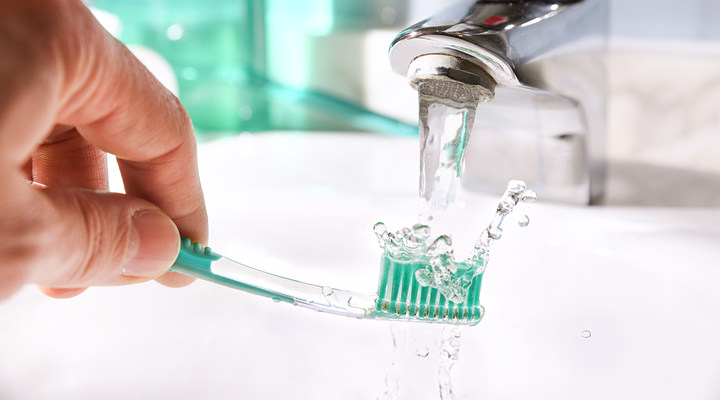When was the last time you cleaned your toothbrush?
Cleaning your toothbrush probably isn’t at the top of your list of priorities, but it should be! Keeping the tool you use to clean your mouth is an important step in keeping your oral and overall health in check.
Keep reading to find out why it is crucial to clean your toothbrush, the steps to clean your toothbrush, where to store your toothbrush, and when it is time for a toothbrush replacement.
Why it’s important to clean your toothbrush
A clean toothbrush is vital to keeping your mouth healthy. Over time, various microorganisms can grow on your toothbrush (Yuck!). Even if you rinse your toothbrush after using it, it can still be contaminated with bacteria, blood, saliva, oral debris, and toothpaste.
Your toothbrush is exposed to germs in many ways. The most common sources are:
- Mouth: Millions of germs live in your mouth, and some are transferred to your toothbrush during brushing. When brushing, rinse your toothbrush with water and allow it to air dry after brushing.
- Environment: The bathroom is one of the most contaminated places in most households, so it doesn’t come as a surprise that germs could spread to your toothbrush. Remember to rinse your toothbrush before and after you brush and store it in an upright position so water drains off the bristles.
- Packaging: Toothbrushes are not required to be sold in germ-free packaging. When you buy your toothbrush, remember to wash it thoroughly because it could have been packaged with germs on it.
A toothbrush that is loaded with germs carries the risk of getting you or your family sick. Viruses such as the flu can live on your toothbrush. Cleaning your toothbrush regularly is a small step to keeping you healthy.
Steps and signs to clean your toothbrush
Now that you know why it is important to clean your toothbrush, here are steps to make a hydrogen peroxide solution to clean it.
- Mix 1 teaspoon of peroxide with 1 cup of water.
- Swish your toothbrush and let it soak in the solution for 15 minutes.
- Rinse off your toothbrush with water.
- Let it dry before using it.
- Do not reuse the solution and start fresh every time.
This mixture will ensure your toothbrush is clean, but how do you know when it is time to be cleaned?
Some signs it’s time to clean your toothbrush include:
- Sickness: Replacing your toothbrush after being sick is often overlooked, but it is crucial to toss it and replace it. Sicknesses such as the cold and flu linger on your toothbrush even if you try to clean it, so you are better off getting a brand-new toothbrush.
- Sharing: Don’t share toothbrushes. Never share your toothbrush, even with a family member. Bacteria in your mouth should not be shared with others. Make sure everyone has their own toothbrush.
Follow these steps to keep your toothbrush clean and remember to replace your toothbrush if you experience any of the signs listed above.
Storing a toothbrush
Being mindful of where a toothbrush is stored can help keep it clean.
Storing your toothbrush in the shower, near the toilet, or in a dirty cup on your sink might seem convenient, but you should avoid keeping your toothbrush in those places. Keeping your toothbrush away from the toilet is important because whether you see it or not, every time you flush the toilet there are droplets of toilet water being sprayed up into the air.
Store your toothbrush in a location far away from your toilet, preferably in an airtight cabinet. Always store your toothbrush in an upright position.
When to replace your toothbrush
Although you can take all the proper steps to clean your toothbrush and store it correctly, there comes a certain point where you need to replace your toothbrush.
Your toothbrush should be replaced every three to four months. Over time germs and bacteria build on it no matter how often you clean it. Other signs that it’s time for a new toothbrush are fraying bristles and anytime you have been sick.
Taking care of your toothbrush is a small step in keeping you and your loved ones healthy. Remember – this oral health tool is something that goes in your mouth multiple times a day. Why wouldn’t you want to make sure it’s clean?
Looking for additional oral health tips? Check out this blog:

